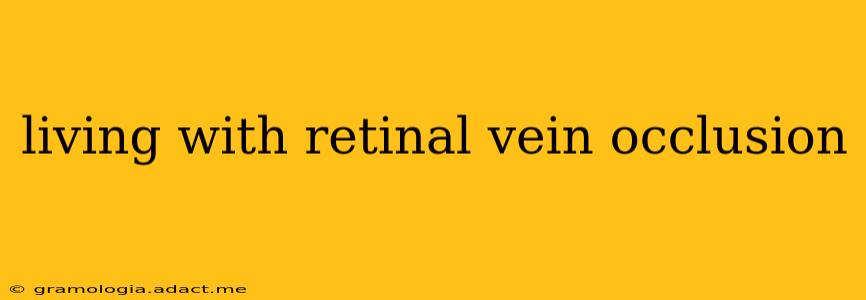Retinal vein occlusion (RVO) is a serious eye condition affecting the retina's blood vessels. Understanding this condition, its symptoms, treatment options, and long-term management is crucial for maintaining eye health and quality of life. This comprehensive guide will address common questions and concerns surrounding RVO, offering valuable insights for individuals and their families.
What is Retinal Vein Occlusion (RVO)?
Retinal vein occlusion occurs when a retinal vein is blocked, preventing blood flow to parts of the retina. This blockage can lead to retinal swelling, bleeding, and damage to the photoreceptor cells responsible for vision. There are two main types: branch retinal vein occlusion (BRVO) affecting a branch of the central retinal vein, and central retinal vein occlusion (CRVO) affecting the main central retinal vein. CRVO is generally more severe. The blockage is often caused by underlying conditions like high blood pressure, diabetes, glaucoma, or high cholesterol, highlighting the importance of managing these risk factors.
What are the Symptoms of Retinal Vein Occlusion?
Symptoms can vary depending on the severity and location of the blockage. Common signs include:
- Blurred vision: This is often the first and most noticeable symptom.
- Floaters: These are small specks or strings that appear to drift across your vision.
- Blind spots (scotomas): Areas of vision loss.
- Reduced vision: A decrease in overall visual acuity.
- Eye pain: Less common, but possible.
If you experience any of these symptoms, it's vital to seek immediate medical attention from an ophthalmologist. Early diagnosis and treatment are essential to minimize vision loss.
How is Retinal Vein Occlusion Diagnosed?
Diagnosis involves a comprehensive eye exam, including:
- Visual acuity test: To assess the sharpness of your vision.
- Ophthalmoscopy: Using an ophthalmoscope to examine the retina.
- Fluorescein angiography: A dye is injected into a vein to visualize blood flow in the retina.
- Optical coherence tomography (OCT): A non-invasive imaging technique that creates detailed cross-sectional images of the retina.
What are the Treatment Options for Retinal Vein Occlusion?
Treatment aims to reduce swelling, prevent further damage, and improve visual acuity. Options may include:
- Medication: Such as corticosteroids to reduce inflammation and blood thinners to prevent further blood clots.
- Laser treatment: To seal off leaking blood vessels and reduce swelling.
- Anti-VEGF injections: Injections of anti-vascular endothelial growth factor medications to inhibit the growth of new blood vessels and reduce swelling.
- Surgery: In rare cases, surgery may be necessary to improve blood flow.
What is the Long-Term Outlook for People with Retinal Vein Occlusion?
The long-term prognosis varies depending on several factors, including the type of RVO, the severity of the blockage, and the individual's response to treatment. While some individuals experience a complete recovery of vision, others may have persistent vision loss. Regular follow-up appointments with an ophthalmologist are crucial for monitoring the condition and managing any complications.
Can Retinal Vein Occlusion Be Prevented?
While not always preventable, managing underlying risk factors significantly reduces the chances of developing RVO. This includes:
- Controlling high blood pressure: Maintaining healthy blood pressure levels is crucial.
- Managing diabetes: Effective diabetes management is essential.
- Treating high cholesterol: Keeping cholesterol levels within the healthy range.
- Maintaining a healthy lifestyle: Including regular exercise, a balanced diet, and avoiding smoking.
What are the Different Types of Retinal Vein Occlusion?
As mentioned earlier, the two primary types are BRVO (branch retinal vein occlusion) and CRVO (central retinal vein occlusion). BRVO affects a branch of the central retinal vein, resulting in localized vision loss, while CRVO impacts the main central retinal vein, leading to more widespread vision impairment. The treatment approach often differs between the two types, depending on the extent of the blockage and the affected area of the retina.
How Long Does it Take to Recover from Retinal Vein Occlusion?
Recovery time varies greatly. Some individuals see significant improvement within weeks, while others may experience a longer recovery period or persistent vision loss. Regular monitoring and adherence to treatment plans are key factors in maximizing recovery potential. The severity of the occlusion and individual factors greatly influence the recovery timeframe.
What are the Complications of Retinal Vein Occlusion?
Potential complications include:
- Macular edema: Fluid buildup in the macula, the central part of the retina responsible for sharp, central vision.
- Neovascularization: The growth of abnormal blood vessels that can lead to further bleeding and scarring.
- Glaucoma: Increased pressure inside the eye.
- Permanent vision loss: In severe cases.
This information is for general knowledge and does not constitute medical advice. Always consult with a qualified ophthalmologist for diagnosis and treatment of retinal vein occlusion. Early detection and appropriate management are essential for preserving vision and improving the overall quality of life for individuals affected by this condition.
